

09/2005
Home improvements again top other housing sectors
by
Kermit Baker, PhD, Hon. AIA
Chief Economist
The vibrant housing market has not only affected the number of homes built nationally, it also has changed the characteristics of these homes. Although some homeowners are looking for less space in their home, which is more customized to their lifestyle, others remain interested in enlarging their living space, particularly with additional rooms to provide opportunities for special functions. Home offices, for example, continue to grow in popularity among households, while exercise rooms appear to have peaked in many markets.
Households also are looking for other features in their homes. Low maintenance materials and more storage space (kitchen pantries, closets, etc.) are increasing in popularity according to residential architects. Features generally associated with more formal homes—upscale entryways and defined hallways—are decreasing in popularity according to architects.
Business conditions strong
A durable housing market continues to offer business opportunities for
residential architects. Almost 40 percent of responding architecture
firms indicated that billings had increased in the second quarter this
year as compared to the first, while fewer than 10 percent reported
that billings had declined. Residential architecture firms can look
to further gains in business conditions; 42 percent reported an increase
in inquiries for new work during the second quarter, while only 10
percent reported a decrease.
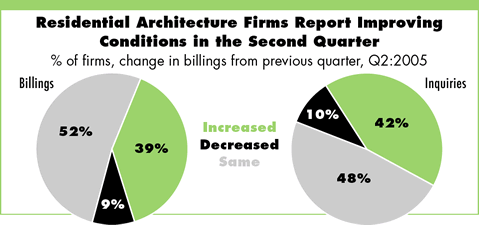
Growing workloads have created an increase in project backlogs at firms. During the first quarter, residential firms reported that backlogs (the amount of design work in house) averaged 5.2 months; by the second quarter they had increased to an average of 5.4 months. Almost a third of residential firms reported that their current project backlogs were six months or greater.
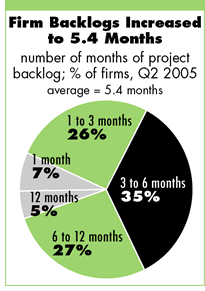 Within a continued strong housing market nationally, the remodeling
market remains as the strongest sector. Both additions and alterations
to existing homes, as well as kitchen and bath remodeling projects, ranked
at the top of the list for improving sectors, with the percentage of
firms rating these market sectors as improving minus the share rating
them as weakening each in excess of 40 percent. The townhouse/condo market
is the other very strong housing sector and the strongest new construction
sector, reflecting the ongoing desire among households to purchase homes
in this low-interest-rate environment, with townhouses and condos often
the only remaining affordable option in many high-priced markets in the
country.
Within a continued strong housing market nationally, the remodeling
market remains as the strongest sector. Both additions and alterations
to existing homes, as well as kitchen and bath remodeling projects, ranked
at the top of the list for improving sectors, with the percentage of
firms rating these market sectors as improving minus the share rating
them as weakening each in excess of 40 percent. The townhouse/condo market
is the other very strong housing sector and the strongest new construction
sector, reflecting the ongoing desire among households to purchase homes
in this low-interest-rate environment, with townhouses and condos often
the only remaining affordable option in many high-priced markets in the
country.
The second tier of housing sectors covers the more traditional upscale construction segments: move-up homes (for buyers trading up to more expensive housing) and custom/luxury homes (newly constructed homes at or near the top of the price spectrum). Both of these sectors are strong—each with about 30 percent of respondents reporting them as improving and only 7–9 percent reporting them as weakening—but clearly a step below the remodeling and condo sectors.
The second-home market remains reasonably solid, with about 27 percent of respondents reporting it as improving and 13 percent reporting it as weakening, while the first-time homebuyer market remains stable, with virtually as many respondents reporting it as weakening as are reporting it as improving.
 Conditions strongest in the South
Conditions strongest in the South
The residential market remains strong nationally, but residential architecture
firms in some regions report stronger business conditions than in others.
As in the first quarter of 2005, firms in the South are most upbeat
about conditions, with more than half of responding firms reporting
increased billings during the second quarter. More than 40 percent
of firms in the West reported a growth in billings in the second quarter,
compared to 30 percent of firms in the Midwest and 27 percent of firms
in the Northeast. Firms in the Northeast indicated the most caution
in business conditions, since 44 percent of firms in this region reported
an increase in billings during the first quarter of 2005.
Telecommuting and relaxation in; fitness
waning
With home sizes generally continuing to grow, homeowners are able to
add more features to meet their evolving lifestyles. One room type
growing quite substantially in popularity is the home office. Home
offices not only accommodate home businesses, self-employed individuals,
and regular telecommuters, but also provide more flexibility for working
a portion of the workweek at home, or for those working some extra
hours on nights and weekends.
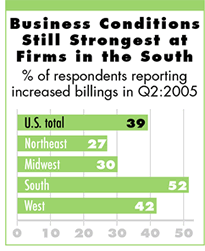 Several other special function rooms are gaining in popularity according
to residential architects. Recreation rooms and mud rooms provide space
for activities and allow households (particularly those with growing
families) to get outerwear out of the main living spaces in the home.
Several other special function rooms are gaining in popularity according
to residential architects. Recreation rooms and mud rooms provide space
for activities and allow households (particularly those with growing
families) to get outerwear out of the main living spaces in the home.
With growing audio- and video-technology options, media rooms also are gaining in interest in many markets. Almost 38 percent of respondents reported growing popularity for media rooms, but almost 14 percent reported them to be declining in popularity.
Dedicated living space for other household members also is seen to be increasing in popularity. This may be a wing of the home for children or guests, or a suite in the home—typically with a private bath and often with separate kitchen and living space—for aging parents or live-in child-care providers. More than a third of respondents reported increased popularity of au pair or in-law suites; however, 15 percent also reported a declining popularity for these special function areas, the most of any listed in the survey.
Laundry rooms remain a popular feature, according to most residential architects, but the popularity of exercise rooms seems to be beginning to wane in some markets.
 Home features emphasize convenience and informality
Home features emphasize convenience and informality
The increasingly popular features that architects are reporting in homes
mirror the special function rooms in that they reinforce the desire
for ease of use and more flexible use of space in the home. At the
top of the list are low-maintenance materials—for siding, decking,
floor and wall finishes, and countertops, among others—which
over half of respondents report to be increasing in popularity and
fewer than 2 percent report as decreasing.
Close behind is storage space, either an enlarged pantry off the kitchen or more closet or general storage space throughout the house. A related trend is the increasing popularity of easy-to-use features (e.g. handles, faucets), which not only encompass a general convenience issue, but increasingly are necessities for an aging population.
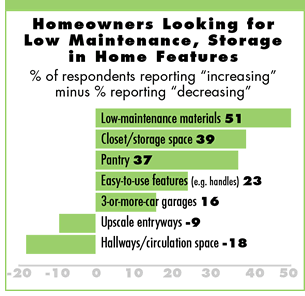 At
the other extreme is the waning popularity of several previously popular
upscale features. In spite of growing automobile ownership nationally,
multi-car garages (three or more cars) are not increasing in popularity
as fast as most other features. Two special features are reported to
be declining in popularity: upscale entryways and hallway/circulation
space in the home. Upscale entryways and foyers often are at odds with
the more informal and open layout for homes, which is growing in popularity.
Hallways, likewise, are more popular in homes with a more formal layout,
where room boundaries are more clearly defined and dedicated hallways
connect more tightly defined rooms. For both entryways and hallways,
more respondents felt that these features were decreasing in popularity
than felt they were increasing.
At
the other extreme is the waning popularity of several previously popular
upscale features. In spite of growing automobile ownership nationally,
multi-car garages (three or more cars) are not increasing in popularity
as fast as most other features. Two special features are reported to
be declining in popularity: upscale entryways and hallway/circulation
space in the home. Upscale entryways and foyers often are at odds with
the more informal and open layout for homes, which is growing in popularity.
Hallways, likewise, are more popular in homes with a more formal layout,
where room boundaries are more clearly defined and dedicated hallways
connect more tightly defined rooms. For both entryways and hallways,
more respondents felt that these features were decreasing in popularity
than felt they were increasing.
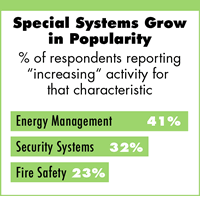 Energy management, home-safety systems generally becoming more popular
Energy management, home-safety systems generally becoming more popular
With rising energy costs, households are becoming more sensitive to energy
use within the home and concerned with more efficient energy-management
systems. More than 40 percent of respondents report that these systems
are growing in popularity, while fewer than 3 percent report a decrease.
Security systems—including home monitoring systems—are
also increasing in popularity according to almost a third of respondents.
Fire-safety systems are stable in popularity according to most respondents,
although more than 20 percent did report increased usage.
Copyright 2005 The American Institute of Architects.
All rights reserved. Home Page ![]()
![]()
 |
||
|
||